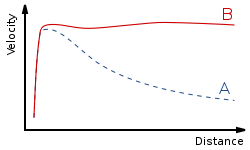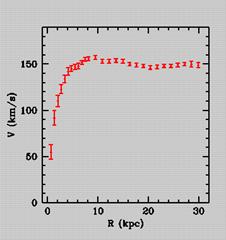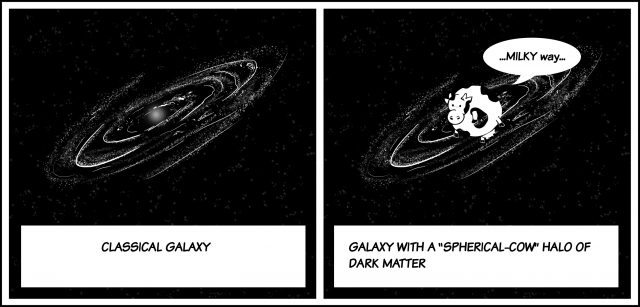Attacking the spherical cow model of dark matter
A couple of weeks ago I had the chance of having a fulfilling chat with Riccardo Cerulli, one of DAMA main researchers. They are at the very center of a skepticism tornado about their results on Dark Matter direct detection, and I asked as many questions as he let me to try to solve this riddle. Okay, some context first: DAMA is a Dark Matter experiment based on Gran Sasso, an underground lab in Italy. There are many Dark Matter experiments in the world, but this one is special. They claim that they’ve been “seeing” Dark Matter for almost fourteen years! There are other experiments, fairly similar in some cases, more sophisticated in others, but they report zero detection. There is a controverted case with other experiment named CoGent, but we will get into it.
Dark Matter is one of today’s great mysteries. It all began when astronomers started measuring the rotational speed of galaxies. One could think that the farther from the galactic center the slower is the angular speed of a certain star in his galactic orbit. The farther from the gravitational source the weaker its effect. Nope, the speed maintains with the distance. The rotational angular speed increases with distance, and at certain point it keeps constant. Such illogical galactic behavior could be caused by two things: there is extra unseen -dark- mass gravitationally pulling the stars, or Newton was wrong and gravity does not work as we were taught. The second proposal, known as MOND (Modified Newtonian Dynamics) is losing ground against the Dark Matter model. Without entering in too many details, I will say that today’s little understanding of this area implies some kind of galactic halo of weakly interacting massive particles, or WIMPs -the kind of Dark Matter that seems to fit all the models- and a particular WIMP distribution around the Solar System and the Earth itself, deduced from the position of the Solar System in this hypothetical Dark Matter galactic halo. Supposedly, there is some kind of WIMP wind hitting the Earth as it moves around the sun. Like the famous neutrinos, a WIMP is hardly detectable, so we may be diving in a Dark Matter sea and no one would know. Well, not just anyone. There is DAMA, of course, claiming to feel this Dark Matter for almost fourteen years.


The DAMA experiment tries to catch the moment of the collision between one of these hypothetical WIMPs and an atomic nucleus. Since the probability of interaction is astronomically low they made a huge detector with a target mass of 232.8 kg, consisting of 25 highly radiopure scintillating thallium-doped sodium iodide crystals placed in a 5 by 5 matrix. The idea is to wait for a WIMP-nuclei collision, and then measure the nuclear recoil. This is achieved trough the scintillation, which is the propriety of a material of emitting photons in response to an energy yield, like the stopping of that recoiled nucleus. This light is seen by photomultipliers, a device that generates an electrical pulse dependent on the energy and quantity of photons hitting its window in a given moment. Of course, almost anything from ambient radiation can yield some energy in the target mass, so background modeling and rejection is a must. The experiment needs to be shielded from the cosmic rays (muons, neurinos, protons…) and that is why it is underground, in the Gran Sasso laboratory in Italy, almost 1.4 km below the surface.
DAMA has limited detection capabilities, and here comes the magic: they are trying to see something called the annual modulation effect. The most simple Dark Matter distribution model, known as “the spherical cow model”, consists on a static spherical WIMP halo around the galactic center, expanding to half the galaxy. Our Solar System moves trough this halo as it orbits the galactic center, so there should be a constant wind of Dark Matter hitting the Earth. Well, not that constant.

The Earth is orbiting the Sun. On June 2nd the earth is moving in the direction of the Sun’s orbit around the galaxy, and on December 2nd the Earth is doing the opposite. So one could expect harder collisions with WIMP’s in the vicinity of June 2nd and softer in the other case. It’s curious that in this particular case the lower the energy of the interaction the greater its probability, so one could actually expect fewer collisions when the energy of the collision is higher (that’s, in the half-year centered on June 2nd where the Earth’s speed orbiting the Sun adds to the Sun’s speed orbiting the galaxy), and more collisions when the energy of the collision is lower (in the other half of the year, centered on December 2nd, when the two velocities are subtracted). So this yields the famous annual modulation, and DAMA claims seeing it for almost fourteen years.

A paper was recently posted on arXiv (an internet repository for preprint versions of papers – not peer-reviewed) claiming that the signal seen in DAMA can be explained from a combination of neutrons from muons and neutrinos 1. From time to time someone tries to attack the gates of the DAMA fortress with more and more sophisticated models fitting their data. This case is special (for me) because I got the chance of asking Riccardo Cerulli himself, a researcher from DAMA, since we meet during ICHEP 2014, the most important high energy physics in the world, held this year in Valencia. The paper says that the DAMA annual modulation can be explained by neutrons. Those neutrons would be generated by two sources: solar neutrinos and atmospheric muons, scattered in the rock of Gran Sasso and the shielding of the experiment, generating neutrons trough various reaction types. Alone these contributions cannot explain anything, but combined they reproduce the signal with the same precision level as the Dark Matter hypothesis. The creative side of the attack is that muon-produced neutrons might explain the amount of data measured, but the peak of the modulation effect would be shifted 30 days forward. Adding a solar neutrino-generated neutrons contribution should shift the phase of the modulation to just the right one (peaking around June 2nd), fitting the DAMA data with the same precision as Dark Matter models. So yes, this is a pretty big attack. The authors of the aggression themselves tell in the paper the wide range of scenarios where their model doesn’t work. This model needs precise simulations to correctly model the actual flux of muon and neutrino induced neutrons. Also, atmospheric muon flux have a 10.7 +/- 0,3 year phase, and solar neutrinos may have an 11-year phase (following the activity phase of the Sun), and other two or three year phases. This cannot be seen in DAMA modulation, because they extract the residuals of their data on a yearly basis, killing any of these effects.

I put this paper in front of Cerulli, and he pointed me to some published papers about DAMA. They have studied in the past all sorts of muonic, neutrino, cosmic, ambient or divine contributions that could mimic their data and rejected them all as sources for their signal 234, so this attack will probably fail as every other before did. In his own words “…in the paper you send me arguments already discussed and ruled out are repeated.”. There is, in my opinion, a suspicious lack of transparency from DAMA. The scientific community is desperately requesting them to make public their raw data, so anyone may repeat their analysis, or try to see these two or three year phases. DAMA keeps saying that everyone should be happy with the data on their papers, but you know, this is Science: extraordinary claims need extraordinary proofs.
References
- Jonathan H. Davis (2014) “Fitting the annual modulation in DAMA with neutrons from muons and neutrinos” http://arxiv.org/abs/1407.1052 ↩
- Bernabei R., P. Belli, F. Cappella, V. Caracciolo, R. Cerulli, C. J. Dai, A. d’Angelo, A. Marco, H. L. He, A. Incicchitti & X. H. Ma (2012). No role for muons in the DAMA annual modulation results, The European Physical Journal C, 72 (7) DOI: http://dx.doi.org/10.1140/epjc/s10052-012-2064-4 ↩
- BERNABEI R., P. BELLI, S. d’ANGELO, A. DI MARCO, F. MONTECCHIA, F. CAPPELLA, A. d’ANGELO, A. INCICCHITTI, V. CARACCIOLO, S. CASTELLANO & R. CERULLI (2013). DARK MATTER INVESTIGATION BY DAMA AT GRAN SASSO, International Journal of Modern Physics A, 28 (16) 1330022. DOI:http://dx.doi.org/10.1142/s0217751x13300226 ↩
- Bernabei R., P. Belli, F. Cappella, R. Cerulli, C. J. Dai, A. d’Angelo, H. L. He, A. Incicchitti, H. H. Kuang, J. M. Ma & F. Montecchia (2008). First results from DAMA/LIBRA and the combined results with DAMA/NaI, The European Physical Journal C, 56 (3) 333-355. DOI:http://dx.doi.org/10.1140/epjc/s10052-008-0662-y ↩
1 comment
[…] Materia iluna misterio bat dela ez da berria. Interesgarria suertatzen ari dena da, misterio honen ebazpenera eroango gaituen prozesua ikustea. Hipotesi eta esperimentu desberdinak eta batzuk eta besteen arteko eztabaidak. Eztabaida hauen atal bat dakarkigu Víctor Marinek: Attacking the […]